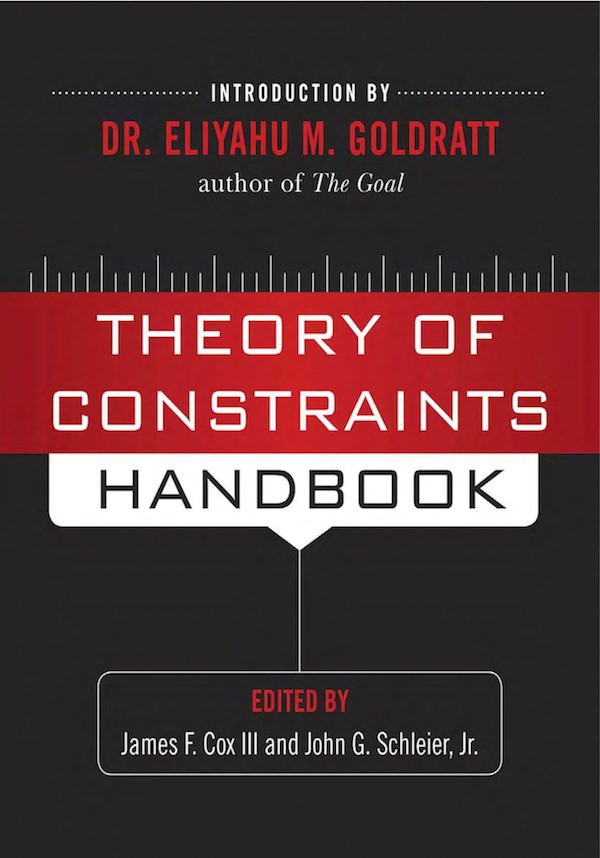From DBR to Simplified-DBR for Make-to-Order (Chapter 9 of the Theory of Constraints Handbook)
Eli SchragenheimInfo
Level of TOC knowledge acquired:
Introductory, Advanced and IntermediateLength:
30 pagesDesigned for:
Consultants, Executives, Implementers, Managers and Shop Floor workersTopics:
Operations/ProductionApplication:
Buffer Management, Drum-Buffer-Rope and Five Focusing StepsLanguage:
EnglishFormat:
DownloadShare
Recommend
Simplified-Drum-buffer-rope (S-DBR) is a variation on the well-known Drum-buffer-rope (DBR) production planning methodology.
The chapter explains the change in thought that has guided the change, and then details the new features of the S-DBR method for make-to-order.
The planning process is analyzed by three different perspectives.
- First, by the five focusing steps, a cornerstone in the TOC thinking.
- The second by recognizing the distinction between planning and execution that aim to handle the uncertainty in the best way.
- The last perspective is the four rules of flow, Dr. Goldratt’s reflections on the achievements of Henry Ford and Dr. Ohno
The chapter explains the main ingredients of the planning methodology: the use of just one buffer, the load control on the weakest link (planned-load), and how they determine the safe-date for any new order. Then the role of buffer management to handle the one and only priority scheme in the shop is explained in detail.
Additional issues include the use of capacity reservation to handle situations of committing to very fast response to certain customers. Also discussed is the idea of the “slack” – taking advantage of offering the standard lead-times rather than offering the earlier safe-date.
The scope of S-DBR is carefully analyzed showing how most of the ‘complexities’ of certain shop floors can be resolved. Situations where certain changes to S-DBR are necessary are analyzed as well. The last part of the chapter deals with implementation issues.
Content
- A Historical Background and Perspective
- Three Views on Operations Planning and Execution
- Challenging the Traditional DBR Methodology
- Outlining the Direction of the Solution
- Where S-DBR Fits Nicely
- Implementation Issues and Processes
- Looking Ahead to MTS
Content:
- A Historical Background and Perspective
- Three Views on Operations Planning and Execution
- Challenging the Traditional DBR Methodology
- Outlining the Direction of the Solution
- Where S-DBR Fits Nicely
- Implementation Issues and Processes
- Looking Ahead to MTS
Comprehensive coverage of the Theory of Constraints
Complete Table of contents of the Theory of Constraints Handbook
- I: What is TOC?
- II: Critical Chain Project Management
- III: DBR, Buffer Management, and Distribution
- IV: Performance Measures
- V: Strategy, Marketing, and Sales
- VI: Thinking Processes
- VII: TOC in Services
- VIII: TOC in Complex Environments
- Theory of Constraints in Complex Organizations
- Applications of Strategy and Tactics Trees in Organizations
- Complex Environments
- Combining Lean, Six Sigma, and the Theory of Constraints to Achieve Breakthrough Performance
- Using TOC in Complex Systems
- Theory of Constraints for Personal Productivity/Dilemmas
- IX: Summary
About the Authors:
James F. Cox III, Ph.D, CFPIM, CIRM, holds TOCICO certifications in all disciplines. He is a Jonah's Jonah, Professor Emeritus, and was the Robert O. Arnold Professor of Business in the Terry College of Business at the University of Georgia. Dr. Cox has written three books on TOC.
John Schleier holds TOCICO certifications in all disciplines. He was President and Chief Operating Officer of the Mortgage Services Division of Alltel, Inc., Executive Vice President of Computer Power, Inc., and Director of Office Systems and Data Delivery for IBM.









































